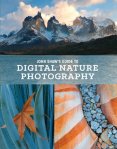 “THE ACT OF PHOTOGRAPHY is the capture of optimal data. The ART of PHOTOGRAPHY is the capture of optimal vision.” Taking your first picture with a Digital Single Lens Reflex (DSLR) – aka a digital camera is like your first love . . . you never forget it!! You may not become the next Gordon Parks or Ansel Adams, but you can become the best you behind a camera. After reading JOHN SHAW’S GUIDE TO DIGITAL NATURE PHOTOGRAPHY you will discover that the possibilities are unlimited.
“THE ACT OF PHOTOGRAPHY is the capture of optimal data. The ART of PHOTOGRAPHY is the capture of optimal vision.” Taking your first picture with a Digital Single Lens Reflex (DSLR) – aka a digital camera is like your first love . . . you never forget it!! You may not become the next Gordon Parks or Ansel Adams, but you can become the best you behind a camera. After reading JOHN SHAW’S GUIDE TO DIGITAL NATURE PHOTOGRAPHY you will discover that the possibilities are unlimited.
KNOWING HOW TO USE your digital camera for more than just a “point and shoot,” camera on autofocus takes practice because “most of us are only occasional photographers; consequently, we’re always starting over in the learning process . . . an understanding of the fundamentals will definitely help you work toward becoming a better photographer.”
WHAT JOHN SHAW’S GUIDE TO DIGITAL NATURE PHOTOGRAPHY offers you is the opportunity to learn from one of the best in his field (without even having to go on a photo tour or take a class). If you are an enthusiastic novice, the occasional amateur weekend shutterbug, or an accomplished photojournalist . . . nothing is taken for granted, no assumptions made in the information shared. What you didn’t know, you learn and what you know is reinforced (or maybe a better/new option is presented).
THE AUTHOR WRITES with caution about buying a lot of equipment or the least expensive when just starting out. Although he clearly has his favorites, which he states that up front. He gives you the reasons why they are on his short list. “The very best equipment, the top-of-the-line camera bodies and lenses, can produce no better than the photographer handling them.”
THOUGHTS for your SOUL:
- “Photography should be both a process of discovery an a procedure for recording that discovery … without passionate involvement, our pictures are noting more than records.”
- “Purchase good equipment, treat it well and learn to use that equipment in the best possible manner … develop your own way of working your own equipment choices, and, most of all, your own vision.”
- “Light has a direction, a character, and a color. The ability to recognize these distinctions and the ways in which they can be used graphically, both singly and in combination, is one of the things that sets the professional apart from the amateur.”
THE STRENGTH OF JOHN SHAW’S GUIDE TO DIGITAL NATURE PHOTOGRAPHY is the simplicity of which the book is written. The author spends a lot of time, often repeating key points (in multiple chapters) to make sure the understanding was clear. This is not a manual that dissects every aspect of photography. It is a resource tool that is designed to be read over and over again until you feel comfortable enough to leave it on the shelf. John Shaw’s belief is that “mastering the technical nature of photography frees you to concentrate on the aesthetic side . . . learning how to control the machine.”
THE ENTIRE BOOK is well written, concise and to the point. The photographic examples were good, but without “before” pictures it was hard to “see” what he’s talking about. After the last page has long been forgotten, the tips that mean the most to you will remain. Nevertheless, with practice and consistency you will become a better photographer, because “without passionate involvement, our pictures are nothing more than records.”
Let’s BOND over BOOKS rates JOHN SHAW’S GUIDE TO DIGITAL NATURE PHOTOGRAPHY as MELODICALLY MEANINGFUL (151-300 pgs.) . . . just the right mixture of content and pages.
Disclaimer: BONDing over BOOKS received this book from the Blogging for Books program in exchange for this review.

